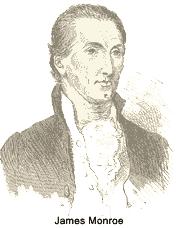Diplomacy under Monroe
James Monroe’s own rich background in diplomacy, plus Secretary of State John Quincy Adams’ experience and negotiating skills, yielded advances in relations with Britain and Spain:

- Rush-Bagot Treaty (1817). Charles Bagot was the British ambassador in Washington and Richard Rush was the acting U.S. Secretary of State. Both powers were interested in averting a naval build-up on the Great Lakes and acted to extend efforts made in the Treaty of Ghent at the end of the War of 1812. An exchange of letters between the two countries led to the almost total disarmament on the lakes and ushered in a lasting period of peaceful coexistence between Canada and the United States.
- Convention of 1818. As a further follow-up to the Treaty of Ghent, Richard Rush, U.S. minister to Britain, and Albert Gallatin, minister to France, met with British authorities and addressed the issue of the western boundary between Canada and the United States. Three major decisions were reached:
- Joint Occupation of Oregon. The Oregon Territory comprised the lands between the 42° and 54°40' north latitude and west of the crest of the Rocky Mountains in present-day Oregon, Washington and British Columbia. Britain and the United States, both claimants to the area, agreed to defer the question of ownership for 20 years and follow a policy of "joint occupation." Citizens of both nations were to be allowed to settle in the region, but in actual practice many more Americans chose to occupy the area. This issue would reemerge in the 1840s as the cause of considerable strife.
- Northern Boundary of the Louisiana Purchase. In the region from the crest of the Rocky Mountains eastward to Lake of the Woods on the border between present-day Minnesota and Canada, the international boundary was established at 49º north latitude — in effect capping the Louisiana Purchase area at that point.
- Fishing Rights. U.S. fishermen were granted rights to ply their trade in the lucrative waters of Newfoundland and Labrador.
- Adams-Onís Treaty (or Transcontinental Treaty of 1819): Secretary of State John Quincy Adams and Spanish minister to Washington Luis de Onís addressed two major problems: (1) the concerns of Georgians who wanted the United States to control East Florida to end Seminole raids, and (2) the Spanish desire to clearly define the boundary between Mexico and the Louisiana Purchase.
Spain in 1819 was not in a strong bargaining position since many of its colonies were in open revolt. This weakness brought favorable terms to the United States. Major provisions included:
- Spain ceded all of East Florida (the area east of the Apalachicola River) to the U.S.
- Spain gave up its claim to West Florida (the area west of the Apalachicola River which included much of present day Alabama and Mississippi)
- The boundary between Mexico and the Louisiana Purchase was settled (largely for the benefit of the United States)
- The United States assumed $5 million in claims by American citizens against Spain
- Spain surrendered its claim to the Oregon Territory (present day Oregon, Washington and part of British Columbia) north of 42 degrees north latitude.
